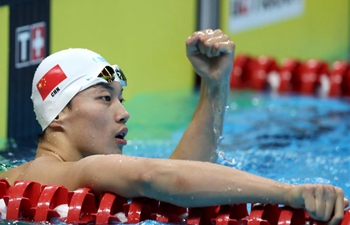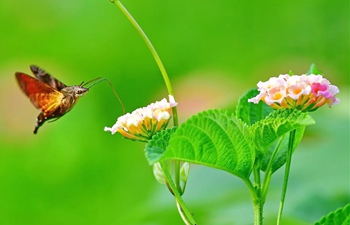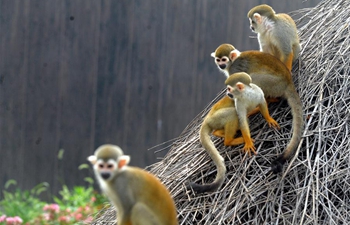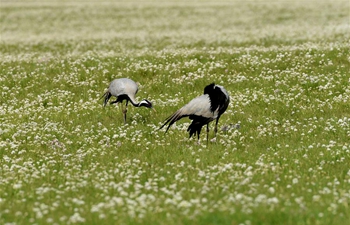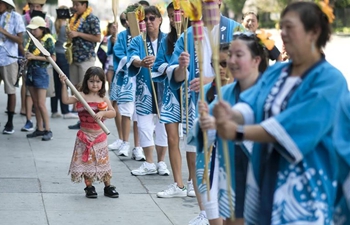TAIPEI, Aug. 20 (Xinhua) -- Imagine a sculpture of a playful, yellow monkey wagging its tail while holding a pink peach in its hands. It smiles from ear to ear, while its eyes vividly staring into the distance. Now imagine the monkey on the tip of a sharpened pencil.
In Chen Forng-Shean's miniature art museum, miniatures like the monkey are everywhere, and can only be observed with magnifying glasses.
"I have always loved miniatures, and I'm determined to pass on the art in Taiwan," said Chen, 62, now retired.
Chen is currently working on pig miniatures in preparation for the coming year, which happens to be the Year of the Pig. The pig comes 12th in the 12-animal zodiac rotation used by the Chinese to represent the year.
BIG LOVE FOR MINIATURES
Chen's studio, a two-story bungalow tucked away in the vegetable fields in the suburbs of Taipei, presents countless "micro works" he has created over the past three decades.
On the second floor, glass shelves hold the miniatures. If looking closely through the magnifying glasses, one can discover another little world: love poems written with Chinese calligraphy on the wings of a bee, a pot plant placed in the eye of a tiny needle, a gold teapot only 2 mm wide, and a 9-mm-long book with 300 ancient Chinese poems.
"I am passionate about traditional Chinese culture, which is why I made all these miniatures with cultural connotations," said Chen, who sports a long, gray ponytail and a traditional red Chinese suit.
Chen's love for miniatures started in the 1960s when he visited the Taipei Palace Museum as an elementary school student.
"I saw the Ganlan olive stone miniature boat created by Chen Zuzhang of the Qing Dynasty (1644-1911)," he said. "There were eight different figures with clear facial expressions, alongside the masts, the doors, and the windows, and there was even a 300-character poem!"
Miniatures have a long history in China. They have been found made out of bones or tortoise shells from the Shang Dynasty (about 1600-1046 B.C).
Chen passionately fell in love with the craft and decided to pass on the traditional culture in Taiwan. From then on, he studied Chinese calligraphy, painting, and sculptures, which laid a solid foundation for his future career.
In 1981, he found a job in a currency printing factory and was assigned to carve steel blocks with steel needles.
"Due to my work at the factory, I had the opportunity and time to practice, and I got familiar with magnifying glasses, steel needles, and mini brush," Chen recalled.
After work, he retired to his studio and concentrated on his "mini world." At the time, there were no miniature artists in Taiwan, and he had to start from scratch.
"It was a lonely and tough road," he said. "Miniature creation demands a lot of concentration, and one careless mistake can destroy the entire piece."
Chen said he often sat for hours in front of a magnifying glass at night working on the mini sculptures and mini engravings.
"There were many setbacks, but the experience also inspired me," he said.
He later created his own olive stone miniature boat, which is well preserved in his studio. The boat, 2.5 cm long and 1 cm tall, also has a poem from the Tang Dynasty (618-907A.D.) carved on the bottom, reminiscent of the one at the Taipei Palace Museum.
CARVING THE FUTURE OF MINIATURES
Chen uses a variety of materials to create his miniatures, including paper, hair, sesame, needles, dragonfly wings, and even ant heads.
His favorite works are the two cute giant pandas he crafted in 2009, three months after the two giant pandas Tuantuan and Yuanyuan were sent to Taiwan from the Chinese mainland in late 2008. The miniatures depict the chubby bears, only 0.7 mm tall each, as they eat bamboo. Later, after Tuantuan and Yuanyuan had a baby called Yuanzai in 2013, Chen added a miniature of Tuanzai to his panda collection.
"Pandas are as chubby as they are cute, and everyone loves them," Chen said. "They represent friendship and peace, which is why I love creating their miniatures."
Chen said he loves the poems from the Tang Dynasty, so he put a lot of those poems into his works on materials such as bee wings. He also carved and placed many lines from famous Chinese poems on other materials, such as matchsticks, cotton threads, etc.
"I try to record our traditional Chinese culture through my works," he said.
These days, Chen often goes to the mainland for cultural exchanges. After climbing the Great Wall in Beijing, he wrote his feelings down on a piece of rice. He also visited temples and Buddha sculptures on the mainland and included these images into his miniature works as well.
"I want to put all the wonderful culture and great views from the mainland into my works," he said.
Chen also feels the responsibility of passing on the 3,000-year-old art of miniatures. Nowadays, students often go to his museum to learn about the craftsmanship.
"It's good to see young people use their imagination to create miniatures," he said. "They are helping with the survival and development of the traditional art."





